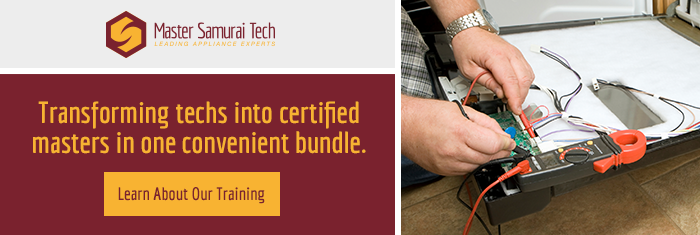Most of the motors in the high-efficiency (HE) washers, such as front loaders, use what’s called brushes to conduct current from the rotor to the stator. You’ll find these kind of motors in common-brand washers made by Frigidaire and Whirlpool (also sold under the Kenwhore label), as well as the over-priced, under-performing, so-called higher-end brands.
A common failure of the these motors is that the brush breaks, cracks or simply wears away. Many of the manufacturers will not sell the brush alone– they want you to buy a whole new motor. But if you can prove that the only thing wrong with the motor is the brushes, then you can save yourself a whole butt-load of cash if you replace only the brushes and not the whole freakin’ motor. Sound too esoteric for an appliance repair virgin to take on? Nay, nay, my feckless grasshopper; grok upon these wise words from Keinokuorma, a Master Appliantologists at the Samurai Appliance Repair Forum who hails from Finland:
Tips on substituting motor brushes, if you just can’t find the original brushes with reasonable price, and especially if warranty is out. After all, a motor brush is just a motor brush: A piece of anthracite or similar conductive material, that carries the current to the commutator lamels.
Whether the original brushes are flattish or square-looking at the end, measure both thickness and width, and you can probably get brushes that match those measures. Also, measure the brush chute and the load spring entirely compressed if you can. Do the math – the brush must fit inside the chute with the spring inserted a bit loosely.
One thing – check the new brush head that is to come into contact with the commutator. It may be flat or concave-curved to contour the commutator. If it is entirely flat, you can install it, but the motor will not give optimum output until the curve has formed. If it is curved, I recommend rounding out the edges a bit with a file. If you use a brush that is curved for a smaller radius of commutator, and you don’t round out the edges, there may be trouble lurking around when starting the motor.
Also, the chute probably has a pinch that grabs the copper twine going into the brush. From the old brush, measure the distance of the warp in the twine to the brush, make a mark at that distance to the twine on the new brush, and lock the mark inside the pinch. This will keep the brush from wearing completely out and the spring hitting the commutator. I’ve seen that happen on motors without such pinches, and usually that means there are a couple commutator lamels stuck into the spring and torn off.
If you can’t get an exactly matching brush, you can think about replacing with brushes that fit the brush chutes width-wise (following the rotation) as closely as possible. Of course, loose is better than tight. And, if you really can’t get matching black carbon brushes, try and find a fitting replacement from car alternator brushes. They are usually of a harder material, and way shorter, but I have successfully used them on old appliances when original spare parts haven’t been available. While they are shorter, you may want to leave a little more twine between the pinch and brush.

